Year: 1984
Directed by: James Cameron
Written by: James Cameron, Gale Anne Hurd
IMDB Reference
Degree of Cyberpunk Visuals: High
Correlation to Cyberpunk Themes: Very High
Key Cast Members:
The Terminator: Arnold Schwarzenegger
Kyle Reese: Michael Biehn
Sarah Connor: Linda Hamilton
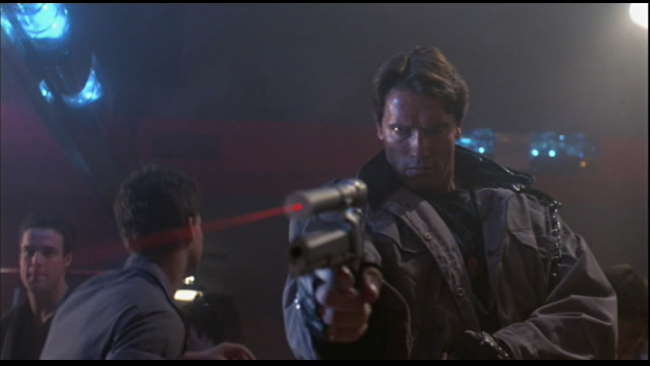
“The Terminator’s an infliltration unit…part man - part machine. Underneath it’s a hyper-alloy combat chassey…microprocessor controled…fully armored - Very tough. But outside its living human tissue…flesh…skin…hair…blood - grown for the cyborgs.”
Overview: No movie has been more imitated in cyberpunk than the Terminator. While most of the imitations have been grade “B” shlock films, they attest to the intense effect that the Terminator had on our consciousness. This film is legendary, and easily ranks in the top 5 or 6 most influential cyberpunk films ever created (Blade Runner, Metropolis, Ghost in the Shell, and The Matrix being the other four, and Alien if you consider that cyberpunk). Terminator is a film with terrific replay value – so much so that I’m guessing all of you have seen it enough times that I don’t need to bore you with a plot overview. With a 6.4 million dollar production budget, this is far from a big-budget blockbuster. The reason it’s stood the test of time, and in fact comes across as a block buster, comes down to incredible execution by beginning film maker James Cameron and cast.
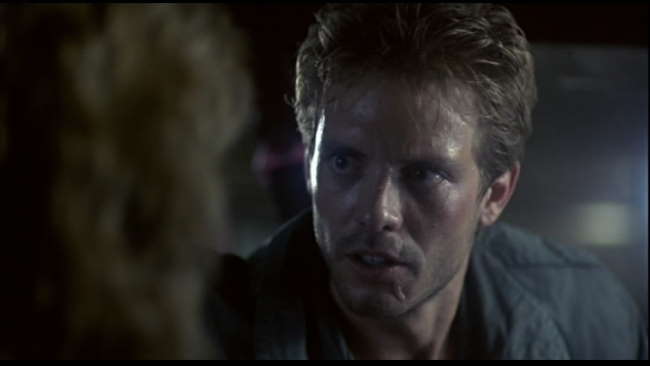
“I’m here to help you…I’m Reece - Sargeant Tech Com BN38416 - assigned to protect you…You’ve been targeted for termination.”
The Acting: From Schwarzenegger’s eery style of acting, to Linda Hamilton’s growth on screen from a shy teen to tough mother of mankind, to Michael Biehn’s tour-de-force performance from beginning to end, the leads flat out carry this movie. That said, the background characters are all terrific, including Bill Paxton at the beginning (“Fuck you, asshole!”), to Paul Winfield (Lieutenant Traxlet), Lance Henriksen (Detective Vukovich) and psychologist, Earl Boen. There are too many memorable scenes to relate here, but the real strength of the acting in this case comes more in expressions and setting mood than it does in delivering the lines, although Beihn’s narrative in particular is riviting.
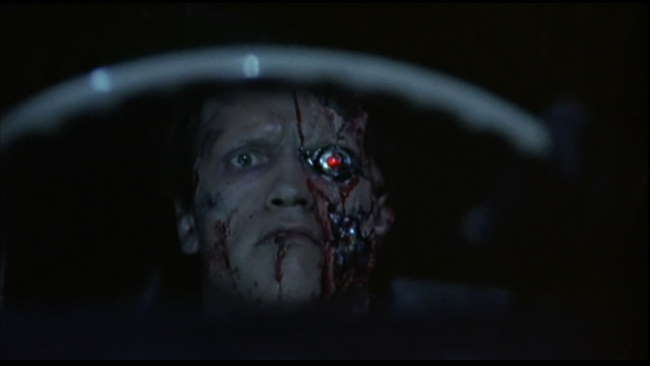
The 600 series had rubber skin. We spotted them easy. But these are new…they look human. Sweat…bad breath…everything…very hard to spot.
Reece’s character does straight exposition to explain the story, which is usually a lousy delivery method. However, the mix of action and exposition just works. The dialogue was terrific, and Reece delivered it in the context of a high-tension chase. During this, Hamilton’s character literally transforms from a vulnerable, girl-next-door to a hard-edged, do-what’s-necessary, take charge kind of gritty leader. Their chemistry is terrific. They have a shy tension, that eventually turns into an intense, believable love affair. It’s kind of amazing that the studio originally wanted Arnold Schwarzenegger to play Reece. Schwarzenegger as the Terminator provides us one of the all time characters in all of scifi. He is the ultimate warrior android, and has been imitated far too many times to count.
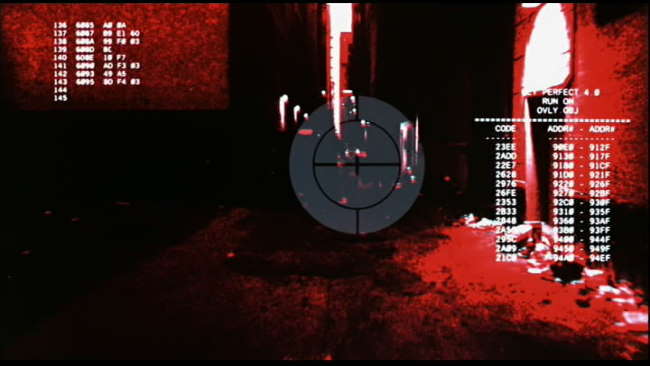
“There was a nuclear war…about a few years from now…all this….this whole place…its gone…just gone… the survivors…here…there…nobody knew how it started…it was the machines, Sarah.”
The Pacing: The Terminator’s pacing is probably the most copied aspect of this film. The Terminator, from the very first scene to the very last is a chase movie. The tension goes from high to massively high to short breathers, back to massively high tension. You literally feel tired after watching this. While this doesn’t seem unusual now, back in the early 80s, The Terminator took the hectic fast pacing of Raiders of the Lost Ark and adapted it to a full scale chase flick. The real magic here was Cameron’s ability to embed a fascinating story into the chase, while changing the bad guy from human to robot to basically add a completely new feeling to the chase.
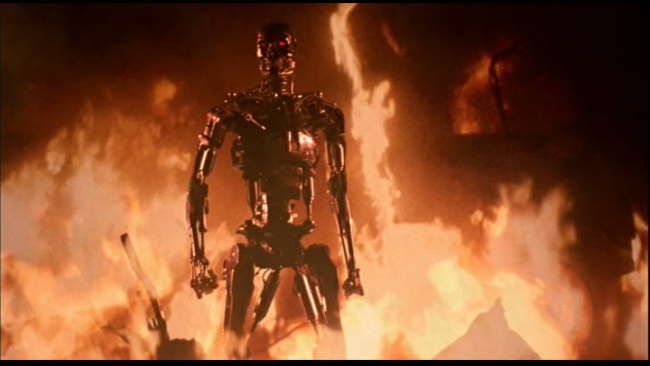
“You still don’t get it, do you…He’ll find her. That’s what he does! That’s ALL he does! You can’t stop him. He’s wade through you, reach down her throat and pull her fucking heart out!”
The FX: For the budget, Terminator’s FX far exceeded anything that should have been possible. The Endoskeleton, made up of miniatures, models and stop-motion animation, is now part of movie lore. The car chase scenes still look terrific, as do the explosions. The near-future dystopic scenes are completely riveting, especially the flying HKs! However, a few of the model shots of Arnold do look slightly dated now (most noticeably when Arnold takes out his eye).
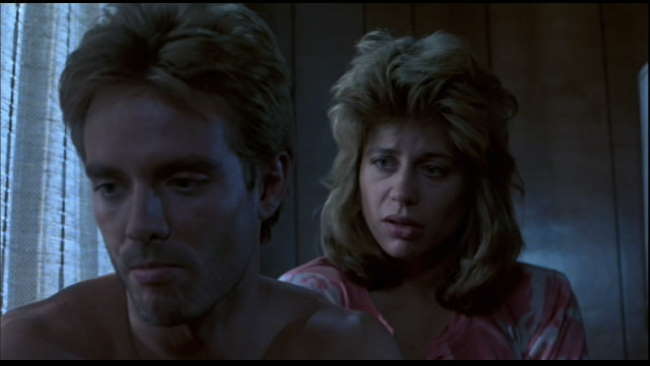
“In the few hours we had together, we loved a lifetime’s worth.”
The Score: Brad Fiedel’s percussive, driving beat that creates an industrial masterpiece that absolutely nails the feeling of The Terminator. You can still here the “dun-dun dun dun-dun” beat and IMMEDIATELY get teleported back to that sense ominous doom of the future that the Terminator portends.
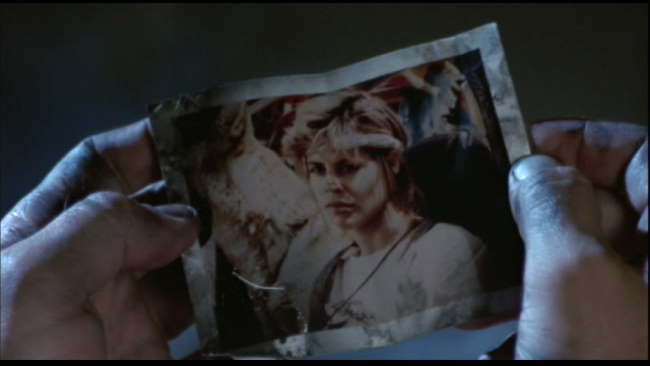
“That was a good hussle, kid.”
Time Travel: The Terminator provides us one of the best time travel movies in cinema. It’s intelligently done in a coherent way that really sets the picture moving. But the real majesty is in the photograph (see above). I LOVE the picture and everything it represents. There, in that one image, we get the entire love affair of Sarah and Reece, John’s struggle relating to someone he knows to be his father (but who cannot know in return), Sarah’s future journey, and a wonderful mind fuck to boot! The placement of the time travel elements at the beginning and ending of the story really do add impact to its meaning.
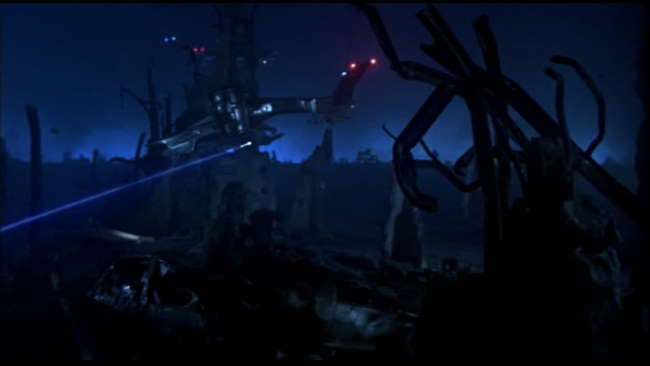
“You stay down by day, but at night you can move around. You still have to be careful because the HK’s use infrared…they’re not to bright…John taught us ways to dust them…”
Guerilla Filmaking: In watching the most awesome extras on special edition DVD, it’s clear that the Terminator was way over-ambitious (thank God!). In post-production, it was clear to Cameron that a number of additional unfunded scenes were needed in order to make a complete picture. Cameron used his weekly director’s pay to pay skeleton crews to go out and do additional shots – often which used incredibly low-end effects. For instance, the body bag used at the end was actually Cameron’s suit bag. The scene at the beginning where Arnold breaks into the station wagon was filmed with just him and Cameron, worrying about the police seeing them as Arnold breaks the car window (Arnold’s clothes for the scene were in his trunk – he had to change in the car!). More incredibly, the last shot of the Terminator, where the red eye slowly fades, was shot later – the smoke you see there was someone breathing cigarette smoke on the eye! In short, everyone gave blood, sweat and tears to make sure this film looked as good as it did.
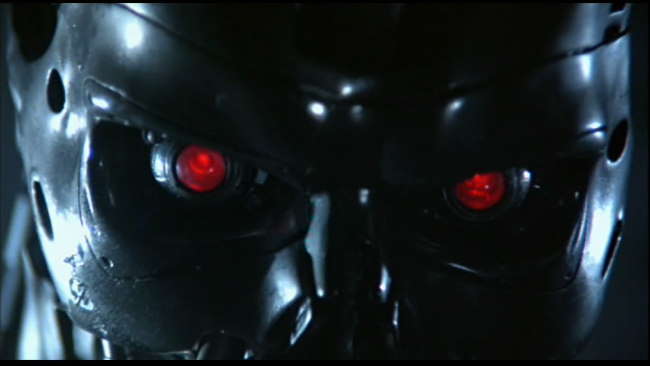
“That terminator is out there…it can’t be bargained with…it can’t be reasoned with. It doesn’t feel pity, or remorse…or fear. And it absolutely will not stop - EVER - until you are dead!”
The Bottom Line: The mood, energy and intensity of The Terminator oozes from every pore of the first shot to the last. If you are one of the very few who has not experienced this movie, you’re in for a treat! If you’ve seen it before (many times even), chances are you’ll be seeing it again. The Terminator definitely deserves a place of honor in the pantheon of cyberpunk flicks. One problem this film does give from a categorization perspective - they call the Terminator a cyborg, but he is really an android (even Cameron calls him this on the extras). The definition of a cyborg implies an augmented human, not an android covered with human tissue. I give it 9 stars as a movie, but add an additional star for its overall impact on film making.
Terminator Page 2: More Screencaps–>>
~See movies similar to this one~
Year: 2004
Directed by: Masahiko Maesawa
Written by: Chinfa Kang
IMDB Reference
Degree of Cyberpunk Visuals: Medium
Correlation to Cyberpunk Themes: Low
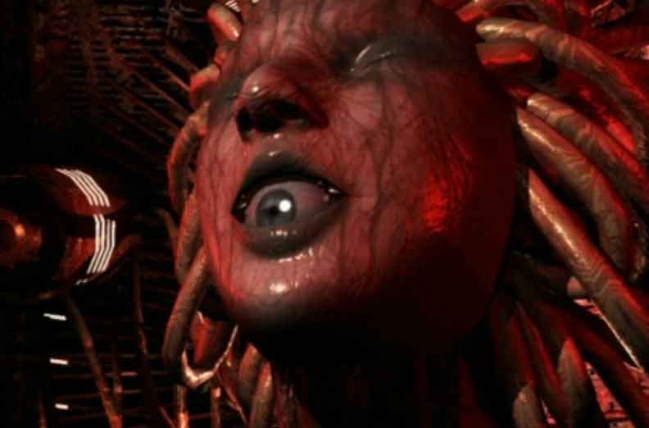
Overview: Galerians Rion is a a low-quality animation - meaning video game quality with a semi-coherent story. Unfortunately, the story too plays like a video game. The star of the video game is a boy named Rion, who wakes up in a bizarre dystopic version of his former world. It turns out that this crazed supercomputer named Dorothy is attempting to become a God and only Rion can stop her. To do so, he needs to find his sister Lilia, who, along with Rion, has been given a virus that combined, can destroy Dorothy. As most RPGs, Rion’s powers grow as he fights the Galerians that Dorothy throws up to block his journey to finding his sister. You can tell the end of the segment, because, um, Rion fights a boss character. Yes, you really are watching someone play a video game here!
The Bottom Line: While I am impressed that Maesawa was able to produce an anime on such a limited budget (I’m guessing a game environment was used to make most of the visuals other than Dorothy), they just aren’t good enough to make for compelling viewing. The visuals are rather fascinating in places - Dorothy (see above) is pretty cool for instance - and certainly are cyberpunk, as is the story, but there just isn’t enough here, either in story or visuals to make this worth recommending. I will give it a point for attempting to do a full scale anime without a budget.
~See movies similar to this one~
Year: 1999
Directed by: Andy & Larry Wachowski
Written by: Andy & Larry Wachowski
IMDB Reference
Degree of Cyberpunk Visuals: Very High
Correlation to Cyberpunk Themes: Very High
Key Cast Members:
Neo: Keanu Reeves
Trinity: Carrie-Anne Moss
Morpheus: Laurence Fishburne
Agent Smith: Hugo Weaving
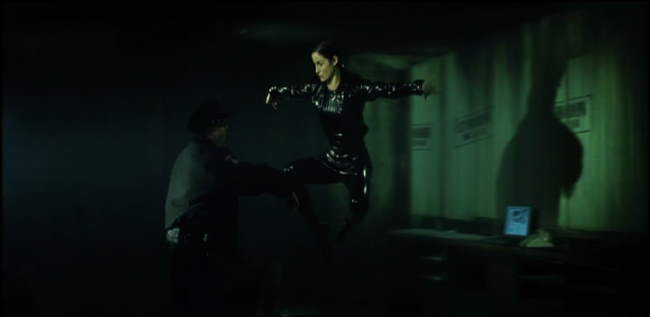
Definitely my favorite opening sequence of all time. Just a great great start to a movie!
Overview: The Matrix is one of my all-time favorite movies, so I’m just not going to attempt to come off as unbiased about it. Additionally, I’m guessing that pretty much everyone who’s coming to this site has seen it - probably numerous times, so I’m guessing a plot description isn’t of much value here. In short, my conundrum with the review is this - what should I say about this movie that will in any way add value to the reader? Answer: Not much. Instead I have decided to keep the bulk of my comments for various essays on the Matrix Trilogy.
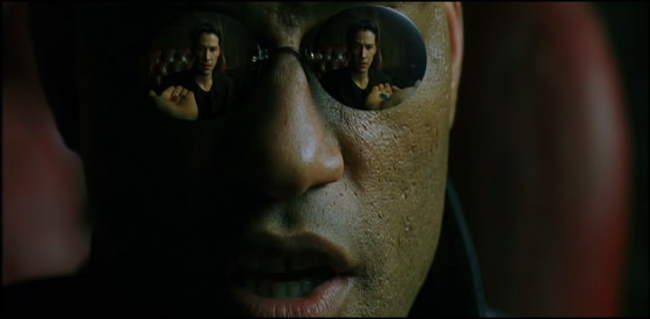
Matrix Influences: The Matrix influenced movies in general and society as a whole. With respect to movies, we see numerous influences, including:
- Special Effects: Bullet time and a myriad of other FX are now standard practice in movies and commercials
- Synonymous with “Cool”: Movies that have a “matrix-like” feel are advertised all the time. We know what this means - it means they aspire to be ultra-sleek, ultra-cool and the “in” thing.
- Fight Sequences: By hiring Hong Kong Martial Arts master Yuen Wo-Ping to coordinate the fights, the Matrix raised the bar on mainstream American movie fight sequences
- Matrix Source Code: The Matrix source code, taken in part from Ghost in the Shell, is everywhere now, and is instantly recognized, as is its meaning
- Hot Chicks in Black Shiny Stuff Kicking Butt: Trinity’s influence has massively upped the anty on action chicks in movies. While Michelle Pfeiffer’s Catwoman in Batman Returns re-initiated this trend, Carrie Anne Moss’ Trinity has made this outfit almost mandatory for female action heroines.
- The use of philosophy in movies: The Matrix seems to have broken the barrier to discussing philosphy in movies. Lets hope this idea lives on.
- Fashion: From Sunglasses, to overcoats to cyberpunkwear, the Matrix has changed the way people dress.

The Bottom Line: The Matrix is already one of the most influential in science fiction, and is truly one of the cornerstone cyberpunk movies in existence. We get it all here: terrific action, awesome cyberpunk concepts, incredible cyberpunk visuals, cool philosophical discussions, an absolutely awesome soundtrack (although DoomAng3l disagrees with this - see his comment below) and innovative FX. On top of this, all the leads were terrific. Reeves makes a perfect Neo, and Moss, Fishburne and Weaving give career-defining performances. Look below for move screencaps on page 2, and additional essays on the Matrix.
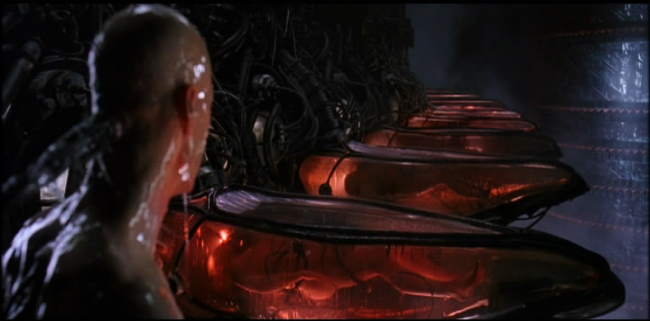
Matrix Essays
- The Matrix Trilogy: A Man-Machine Interface Perspective: This essay explores the Matrix Trilogy specifically from a scifi perspective - the purpose of which is to show how Neo’s journey is really a sequel to Motoko’s transformation at the end of Ghost in the Shell. Developed throughout the trilogy, Neo becomes a fully merged entity comprised of a sentient program with a human.
Page 2: More Screencaps–>>
~See movies similar to this one~
Year: 1993
Directed by: Hiroshi Fukutomi
Written by: Yukito Kishiro (Manga), Akinori Endo
IMDB Reference
Degree of Cyberpunk Visuals: High
Correlation to Cyberpunk Themes: Very High
Key Cast Members:
Gally (Alita): Miki Itô
Ido: Kariya Shunsuke
Yugo: Kappei Yamaguchi
Chiren: Mami Koyama
Vector: Shigeru Chiba
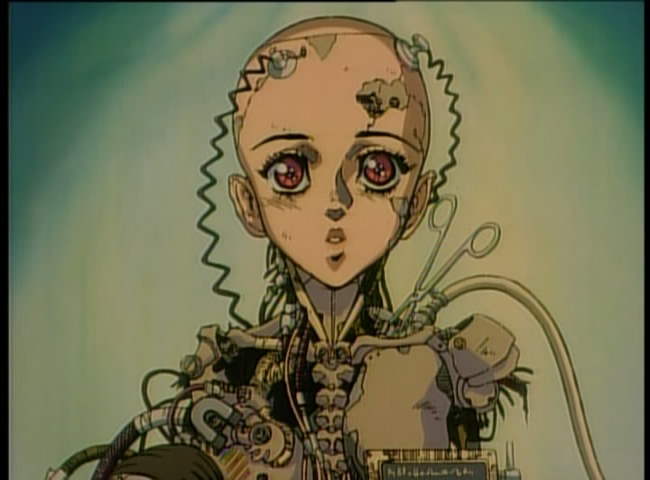
Overview: Battle Angel is based off a very well done Manga series called Battle Angel Alita. The movie covers the first two volumes of the Manga: Rusty Angel, which documents Alita’s “rebirth” and Tears of an Angel, which portrays a tragic love story. This anime from 1993 is one of the best man-machine interface animes out. The story is solid, and the drawing for that time period is terrific. While you might hear some gripe that the Manga is better, I think Fukutomi did a terrific job in taking Kishiro’s story to anime. I can only hope that James Cameron does a similarly wonderful job with the upcoming live action version of this. Just a warning - this is not a kids story - it contains lots of blood, head removals and minor amounts of nudity.
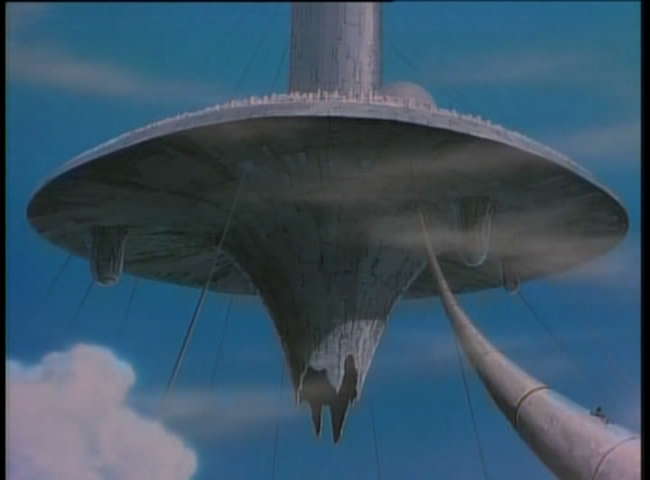
The Setting: Battle Angel takes place far into the future, after a societal collapse has occurred. Advanced human society has been relegated to a floating city called Zalem, that sits above a refuse heap called Scrap Iron City, which is inhabited by denizens living off the scraps and waste products Zalem expels. A corporation called the “Factory,” the primary employer for Scrap Iron City, sends products back up to Zalem through a series of huge metal tubes. Cyborg technology has become a way of life, with many “humans” having only their brain remaining from their original human body host. Scavenging and theft has become a way of life for many. Backbones are a particularly sought after commodity by thieves, who sometimes will violently take them from their living hosts. As social services no longer exist, the Factory posts “bounties” for the heads of the most egregious villians, which bounty hunters, called Hunter-Warriors pursue for money.
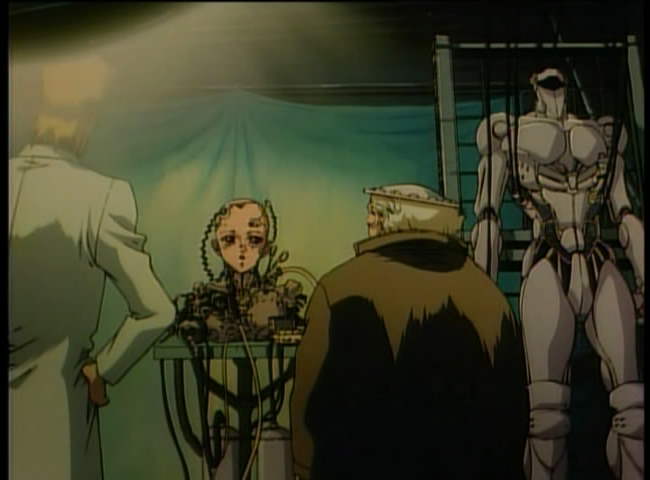
Rusty Angel: Daisuke Ido, an cyborg doctor extraordinaire, former citizen of Zalem, scavenges through the refuse heap to find spare cyborg parts to repair the citizens of Scrap Iron City. One day he comes across a female cyborg head that has a still-living human brain in it. He sets out to repair this head and gives her a wonderful body off of parts he has collected. He names her Gally (she is called Alita in the Manga), and she seems totally restored, except for the loss of memory from her earlier life. Ido becomes attached to Gally and they quickly develop a father-daughter type relationship.

Gally learns that Ido moonlights also a Hunter-Warrior both for moral reasons and to support his medical practice. Gally saves Ido from certain death, and thus, reveals that she, in her former life, was also a very talented warrior. Under protest from Ido, Gally asserts her individuality and desire to become a Hunter-Warrior like Ido, so that she too can have purpose to her life.
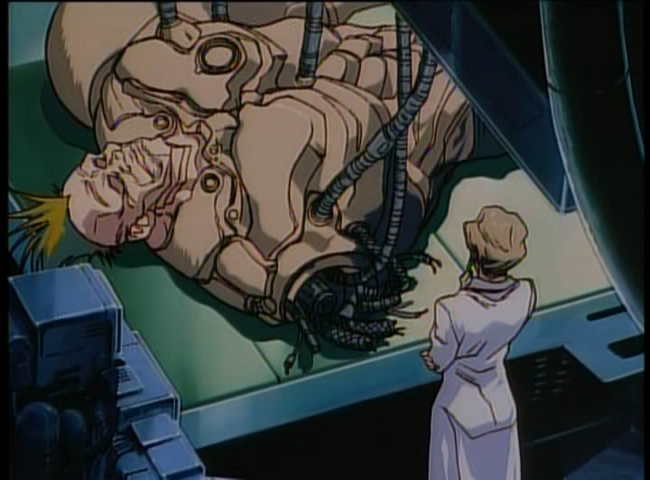
Chiren, also a cyborg doctor and Ido’s former partner, has also been ousted from Zalem, and is consumed with finding a way to return. Deciding that she will do anything to make this happen, Chiren hooks up with Vector, a shady character who has connections with the “Factory,” who agrees to eventually take her to Zalem in return for sexual favors and for her assistance in building a supra-cyborg gladiator named Greweicia for the fighting ring. This cyborg warrior also has a penchant for eating brains, and ends up on the bounty list. Chiren, wanting to be seen as superior to Ido, gets Greweicia to fight Gally in the hopes of destroying her, and thus, destroying Ido.
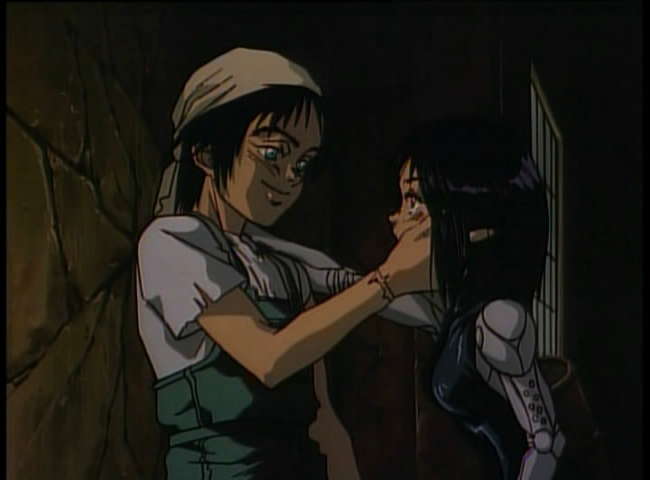
Tears of an Angel: Gally, in exploring the city has become infatuated with a hard working body named Yugo, who dreams of going to Zalem. Although it’s common knowledge that nobody born in Scrap Iron City can ever go to Zalem, Yogo is also consumed with finding a way, and has gotten an agreement from Vector, who promises Yugo if he can make 10,000,000 credits, than he will take Yugo to Zalem. Yugo has taken him up on his offer and has started stealing cyborg spinal cords as a way to augment his day job of fixing machinery. He is discovered, and is put on the Bounty list. Gally, who has fallen deeply in love with him, tries to rescue him from a rival bounty hunter. Unfortunately she is too late, but is able to save his head, and asks Ido to turn him into a cyborg. Even after becoming a cyborg, Yugo’s dreams of reaching Zalem cannot be abated, as he sees his life a struggle against the worthlessness that is the Scap Iron City.
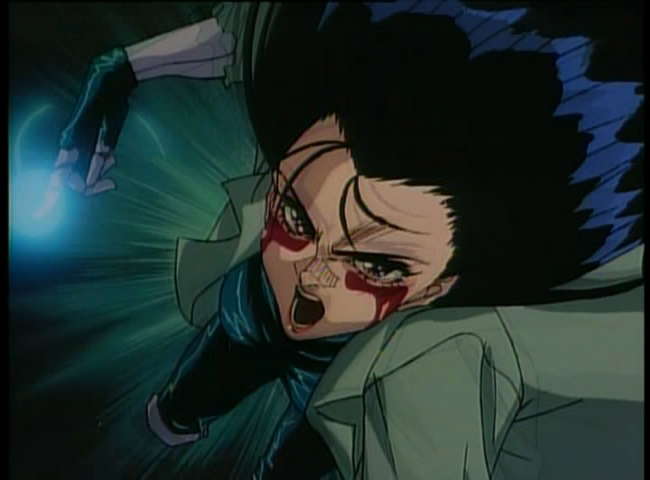
The Artwork: In Battle Angel, we see strong influences of Akira in most every aspect of the production. From the facial expressions to the darkly textured backgrounds to the fighting style approach, Battle Angel clearly has used Akira as a template for modern animation techniques. Like many OAVs of this time period, some of the backgrounds are bland while others are lavishly penned and inked with multi-layered designs. They “pick their battles” with the designs, but for the most part, the decisions are solid. The simple designs are in backgrounds such as the sky and in Ido’s house. The more complex ones are in the underground, Yugo’s hang out, and in the refuse heap scenes – this is where most of the action and plot take place.
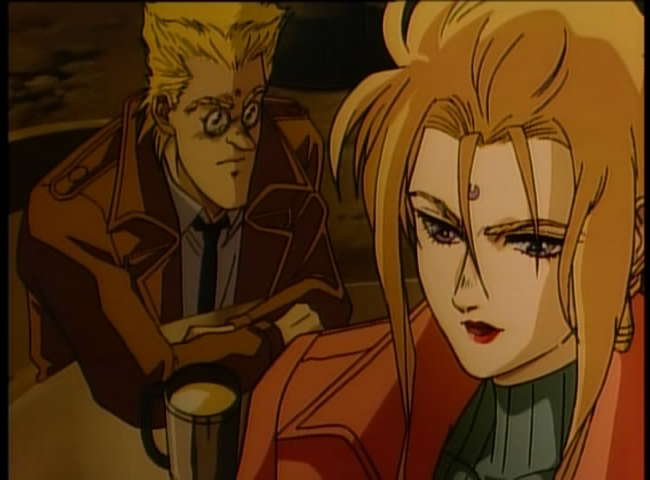
Changes from the Manga: While I think Battle Angel is a terrific anime, there are some changes from the Manga that some find annoying. Most bizarre is the renaming of Alita to Gally, and the city Tiphares to Zalem. However, unlike some, I don’t find the changes in the plot to be that problematic. The anime wonderfully captures the essence of the Manga. Perhaps the biggest change is the rationale for Alita’s powers. In the anime, we really don’t get an explanation, but in the Manga, Alita is first given a normal body by Ido, and ends up destroying it in her first fight. Realizing that Alita is a warrior at heart, Ido gives her the body he has saved for a long time – that of a berserker warrior. The primary villain in Rusty Angel is also different – he is a being who has grown up in the sewers, and after losing his body in fighting Alita, he takes over the Gladiator’s body. And Chiren, a central character in the anime is not in the first to novels of the Manga. Again, for the most part, I have no problems with the changes, and actually love the dimension that Chiren adds.
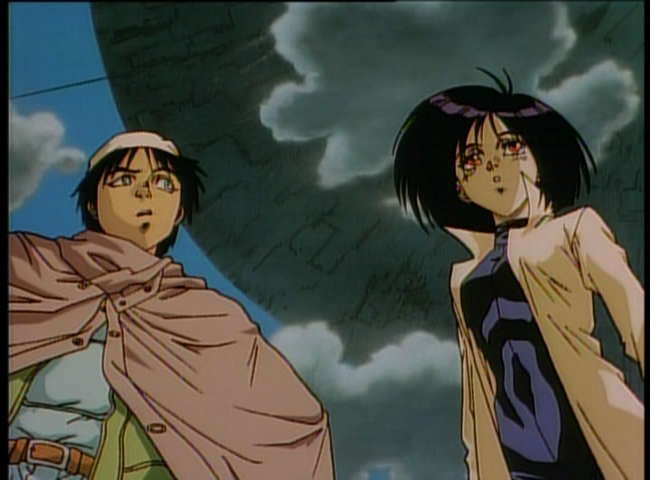
The Bottom Line: Battle Angel (Alita) just works for me as an anime. It is intelligent enough and well enough executed to get you to imagine a world where cyborgs are a reality. The world from the underground perspective is well done and Alita (I call her Alita, not Gally) as a character is terrific. Along with Armitage III and Ghost in the Shell (obviously), Alita is one of the best animes of this kind. Just a caution for those who have only seen the VHS, like most Japanese animes, Battle Angel comes off FAR FAR better with the Japanese dubbing cast than it does the English cast.
~See movies similar to this one~
Year: 1990
Directed by: Paul Verhoeven
Written by: Philip K. Dick (story), Ronald Shusett, Dan O’Bannon et al.
IMDB Reference
Degree of Cyberpunk Visuals: High
Correlation to Cyberpunk Themes: High
Key Cast Members:
Douglas Quaid/Hauser: Arnold Schwarzenegger
Melina: Rachel Ticotin
Lori: Sharon Stone
Richter: Michael Ironside
George/Kuato: Marshall Bell
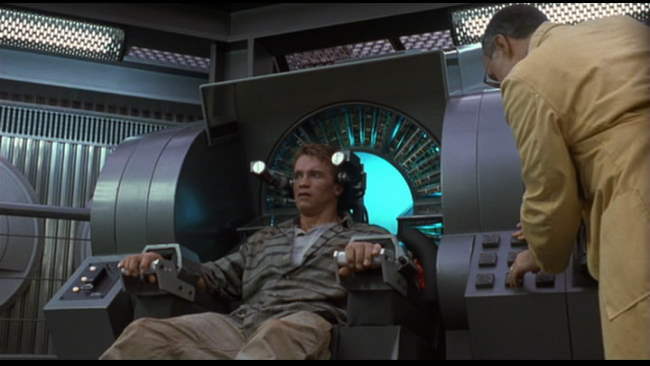
We can remember it for you wholesale!
Overview: Total Recall is one of the better known cyberpunk movies from the late 80s to early 90s. This is cyberpunk all the way with intense memory modification, a dystopic future, and malformed humans of all styles. The visuals are sometimes cheesy, but always pretty fun, and include various shots like a 3-breasted woman, exploding heads, bulging eyes, and this guy below. This is one of Arnold’s better roles, although the story does tend to rely on a continual stream of head-jerking mind fucks.
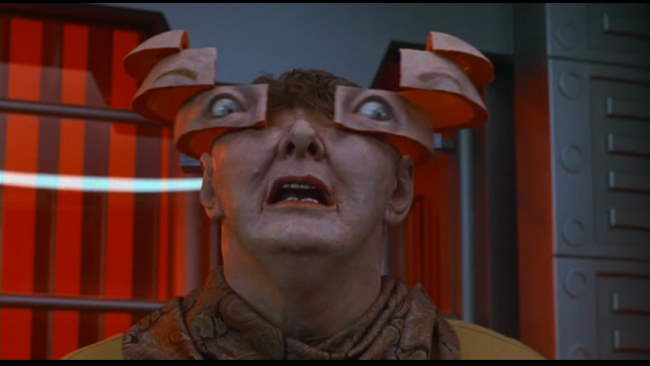
Taken from Philip K. Dick’s story, “We Can Remember it for You Wholesale,” Total Recall stars Arnold Schwarzenegger as an everyday man, Douglas Quaid, who craves something different in his life. He keeps on having realistic dreams about Mars and decides to visit Mars virtually. He goes to “the Recall Corporation” to get some memories manufactured and installed - ones that are exciting, and speak of Mars, espionage and slutty, athletic women!

Unfortunately, things go very wrong. In the process of getting his new memories installed, he wakes up to find that things are not as they seem – in fact he doesn’t know if he woke up at all, or if whether he’s still experiencing a memory impact at the Total Recall Corporation. Things get weirder and weirder, and involve a trip to Mars, and sleazy corporate plots.

Total Recall gets Arnold to truly stretch his emotion capabilities, as we get to see him act in ways he really hasn’t done elsewhere. The rest of the cast isn’t exceptional, but puts in serviceable performances. Rachel Ticotin (the slutty athletic chick), Sharon Stone (Douglas’s wife, or maybe not), Ronny Cox (the evil corporate dude) and Michael Ironside (The evil right hand guy) all provide us with memorable characters.
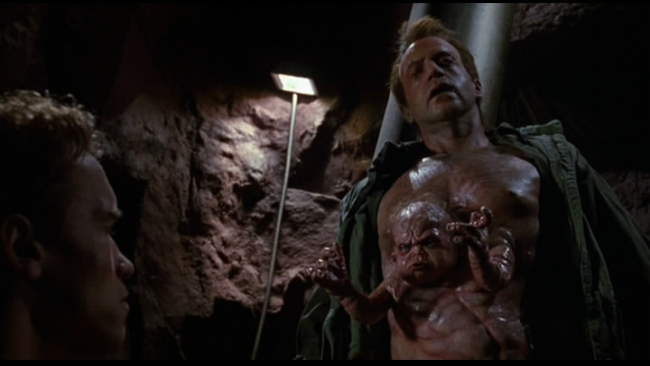
The Bottom Line: All in all, Total Recall is not the greatest movie ever, and has some significant science issues and plot holes, but it’s a truly fun ride with lots of replay potential. It does the memory modification thing very well, and while you get your head jerked around a bit, overall, the plot works.
~See movies similar to this one~
Year: 1989
Directed by: Steven Lisberger
Written by: Tony Kayden (screenplay), Bill Bauer (story)
IMDB Reference
Degree of Cyberpunk Visuals: Very Low
Correlation to Cyberpunk Themes: Low
Key Cast Members:
Matt Owens: Bill Paxton
Byron: Bob Peck
Belitski: Kitty Aldridge
Will Tasker: Mark Hamill
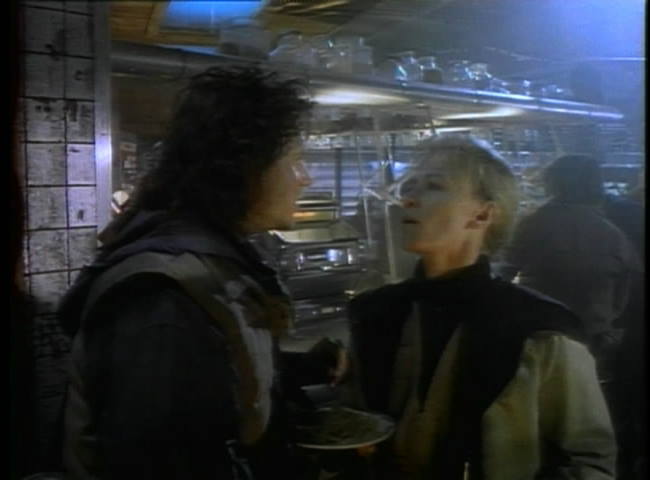
Overview: Slipstream is a movie directed by Tron’s Steven Lisberger, who, thankfully, time has mostly forgotten. This movie is supposed to take place in some future time where the continents have all reshuffled themselves due to Earthquakes (yes, you might think this would take hundreds of millions of years, but Lisberger apparently knows better). For the most part, Slipstream is a pretty lousy movie. Especially lousy are the costumes and set designs. The costumes consists of regular 1980s attire, while the set designs, what little there are seem hastily manufactured with little attention to detail.
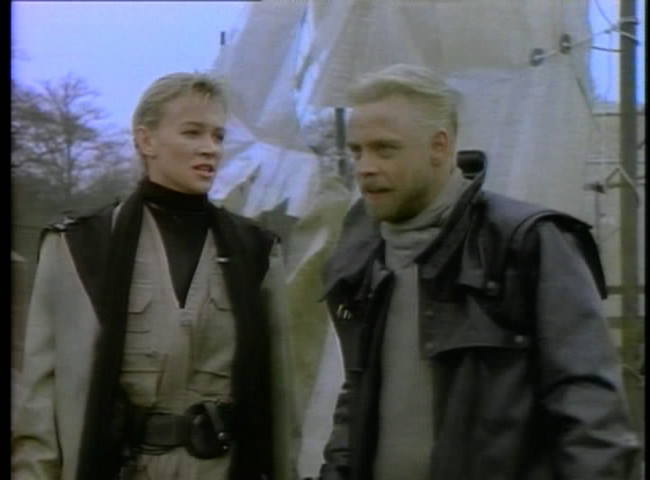
The plot concerns an escaped android named Byron, who’s apparently killed someone, and has escaped to the fringes of society. The police bounty hunters, played by Mark Hamill and Kitty Aldridge, have just caught him after a 3 month trek, and are on their way back to bringing him in. On a stopover to get some food, they run into Matt, played by Bill Paxton, who sees Byron as his ticket to money and happiness. Without knowing he’s an android, Matt steals Byron from the police, and escapes down the “slipstream,” A river running down a huge gorge that seems to generate its own wind power. The rest of the movie is about Byron’s emergence and his friendship with Matt, while still evading the bounty hunters.
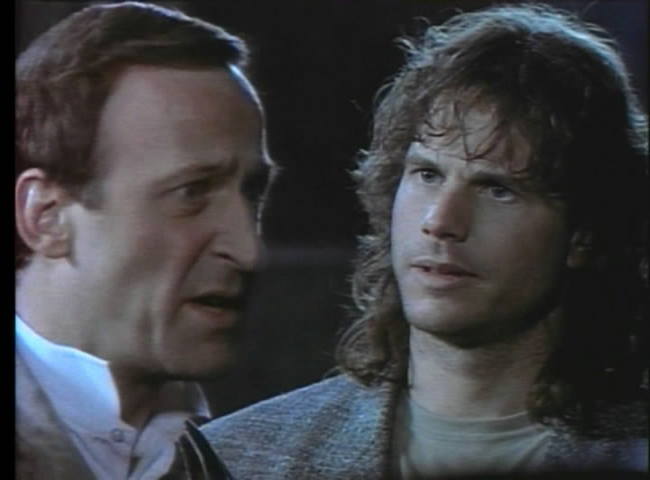
Android Freewill: The only interesting part of this movie concerns a scene where Byron has just been told he’s free, and, experiencing true freewill for the first time, is completely overloaded. He doesn’t know how to handle it and immediately asks for Matt to tell him what to do. This scene is a little too “in your face” but it is the highlight of the movie, and really, pretty much the ONLY aspect of this movie that feels cyberpunk.
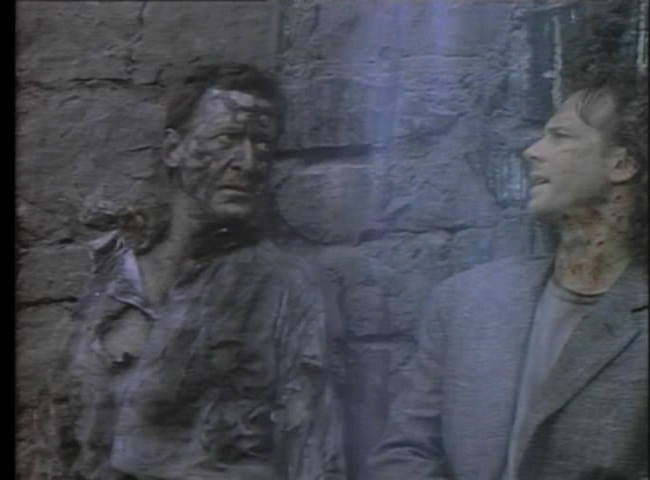
The Bottom Line: There really isn’t much here. If you haven’t seen it, you probably won’t feel too bad. I will say that for the most part, the four acting leads give decent performances - this more than anything allows me to give it 5 stars. It’s a shame they had so little to work with. The plot is forced, the sets are aweful and the costumes are basically what the actors wore to the shoot.
~See movies similar to this one~
Tags: cyberpunk movie review Slipstream
Year: 1971
Directed by: George Lucas
Written by: George Lucas (story and screenplay), Walter Murch (screenplay)
IMDB Reference
Degree of Cyberpunk Visuals: High
Correlation to Cyberpunk Themes: High
Key Cast Members:
THX 1138: Robert Duvall
LUH 3417: Maggie McOmie
SEN 5241: Donald Pleasence
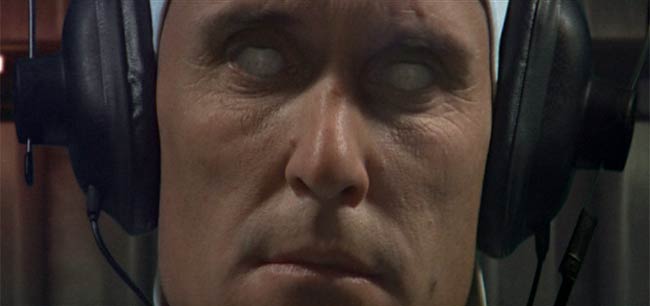
Overview: George Lucas’s THX-1138 is one of the many good small-budget films long forgotten that has found new life on DVD. THX-1138 gives us a wonderful commentary on how Lucas, back in 1971, thought society would be if those in power ever really got their way. Everything here is antithetical to the 60s movement. Freedom and in fact most of humanity is squashed in this depiction of a dehumanizing nightmare society. All actions are controlled and securitized to ensure compliance.
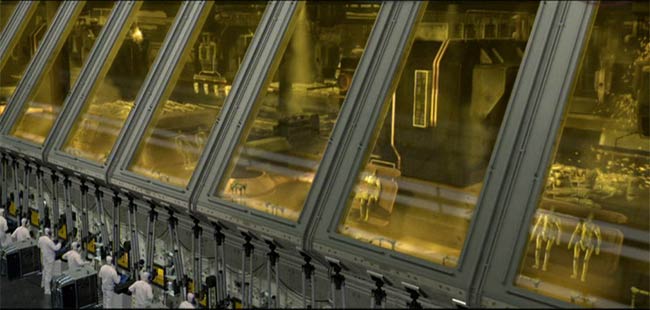
The Setting: THX-1138 takes place in an underground facility in some ill-defined future where all aspects of humanity have been squashed. Everyone has all individuality removed, including possessions, hair (everyone has shaved heads). Humanity is controlled by television brainwashing combined with medications that remove human emotions. All citizens have a have a specific role to perform, and must adhere to completely programmed time schedules. Regularly scheduled “confessions” with mind control officers are used to catch any unexpected problems with individual expression. In this setting, Robert Duvall, known as THX-1138, and his room mate “dare” to have affection for one another.
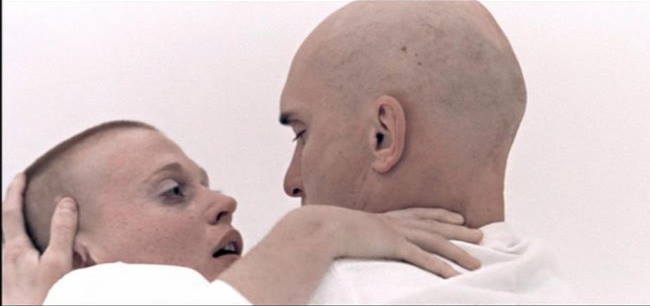
A series of events occur which make THX-1138 disenchanted with society. He begins to cut down on his medication, and convinces his room mate, LUH 3417 to do the same. When emotions return, so does their humanity. They begin to find emotional desire and love for one another, but this is cut short, when a ranking facility member, SEN 5241, decides he would prefer to have THX-1138 for a room mate, and removes LUH 3417. But THX-1138 has gone too far, and instead, seeks out a budging resistance movement. Unfortunately for him, the control group has discovered his deceit.

The Visuals: Like many cyberpunk films, dominating color schemes are used for conveying the moods. In this case, white is used to depict dehumanized society; yellow is used for the controlling machinery, and darkness is used for the unknown innards of the facility’s inner-workings. THX-1138 provides much of the storyline through its visuals. We aren’t told the history of this futuristic dystopia, nor are we given much indication of how this society is run. As an interesting side note, although its never stated, one really gets the feeling in watching this that the powers that be would strongly prefer replacing humans with emotionless robots.
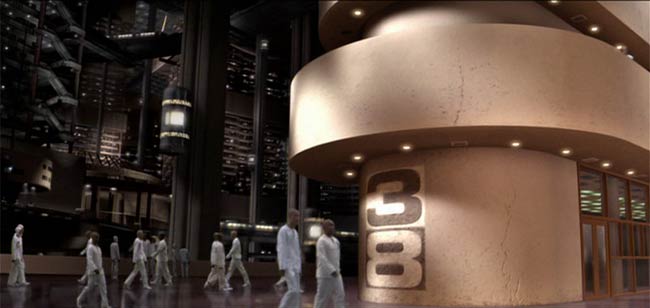
Changes to the Original Release: I have only seen the director’s cut of THX-1138, so I cannot comment on the original cut. However, I notice a similar level of anger to this version as was seen in changes to Star Wars. I probably need to track this down, but not having seen it, I don’t really see many of the problems they list, including poorly integrated CG effects (the shot above is an example of added CG into the background). Many also complain that while the film length is the same, some shots are missing. I don’t notice any complaints about changes to the sound, which seems very well engineered to me. Again though, having come to this movie without seeing the earlier version, I do have a hard time with people stating there is no value to this version, or that it is so far worse than the original that it is not worth watching. These sentiments seem like severe overkill. Still, like Star Wars, one hopes that the original eventually gets released as well.
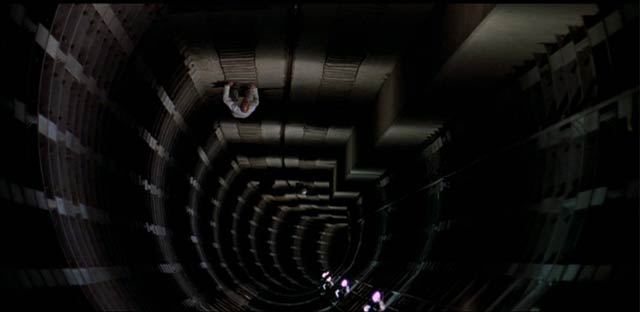
The Bottom Line: THX-1138 is a very well made low-budget art film where Lucas takes the controlling elements in society to what he sees as their logical conclusion. While this isn’t very realistic in many ways, it certainly sends a powerful message. The pacing is consistent and the themes, while not new, are interesting and well conveyed. As long as you’re not looking for lots of action, you will probably enjoy this.
~See movies similar to this one~
Tags: cyberpunk movie review THX-1138
Year: 1995
Directed by: Christian Duguay
Written by: Philip K. Dick (story), Dan O’Bannon & Miguel Tejada-Flores (screenplay)
IMDB Reference
Degree of Cyberpunk Visuals: Medium
Correlation to Cyberpunk Themes: Medium
Key Cast Members:
Joe Hendricksson: Peter Weller
Jessica Hanson: Jennifer Rubin
Becker: Roy Dupuis

Overview: Screamers is a low budget near future outer-space movie with some cyberpunk elements in it. We get all powerful corporations and some interesting android/robot self-replicating development. While it has some serious story issues, and doesn’t always have the best acting or FX, there’s still enough here to make it pretty interesting, especially if you’re a fan of RoboCop star, Peter Weller.

The Story: Screamers takes place in a dystopic near future (2078)e environment, where mining colonies on remote planets have been at war with the N.E.B. Corporation for the past 20 years. After a new substance that made space flight possible, called Berynium, was discovered, the N.E.B. Corporation sent out mining teams to the planet “Sirus 68” to mine the Berynium, but unfortunately, it was discovered that the Berynium was accompanied by massive does of radiation. The miners and scientists on the planey Serius 68 revolted, and soon a larger alliance was formed to fight the all-powerful N.E.B. Corporation.
N.E.B. responded by dropping nuclear bombs to kill the alliance soldiers on Serius 68, and then sent in ground troops to finish the job. The alliance responded by developing “screamers.” Screamers are small sentient robots that can burrow underground at a high rate of speed, and then come up and chop humans to mincemeat. The alliance developed a self-sustaining lab that allowed the robots to self-replicate and included learning algorithms to improve their attack capability. The alliance also included an identification beacon so that the screamers would not attack alliance soldiers. Unfortunately, the screamers have begun to learn, so much so that they have started developing their own models, and worse, have started to disregard the identification beacon.
Commander Joe Hendrickson, who has been on Serius 68 since the beginning of the conflict figures out that the war has forgotten Serius 68, and has decided to try to visit the commander of the N.E.B. forces in order to make a ceasefire. Unfortunately, as he discovers in his trek, the N.E.B. forces are the least of his concerns.
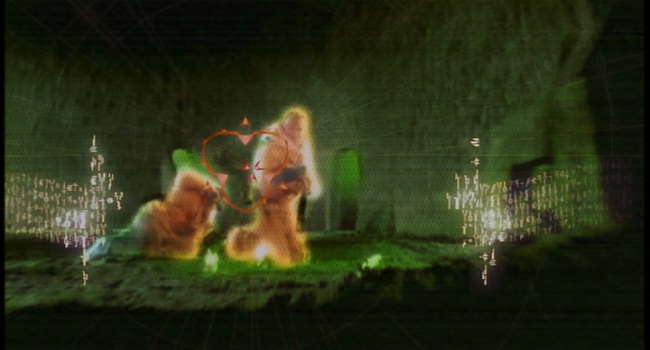
The Visuals: Screamers is a cross between Alien inside visuals and a desert-like Road-Warrior setting (without the punk stuff), or perhaps better said, a Pitch Black setting. Orange is the color du jour. In general, the look and feel of the internal set designs are far less realistic than the outside world. Some of the inside sets would look right at home on a sci-fi TV series. The creatures are pretty low budget too.
The Believability Factor: Although originally based on a Philip K. Dick short story, there are enough problems with the story here that cause you to pause. In addition to some real whoppers regarding the overall plot (for instance, if humans could build adaptive learning robots, why didn’t they just get the robots to mine the radio-active Berynium?), and some serious acting issues on the part of some of the minor characters. Still, both Peter Weller (RoboCop) and Jennifer Rubin are good enough to make this worth watching. More so, the evolution of the robots, while often “magical,” is done at least well enough to make you take pause and actually have a deep thought or two about it.
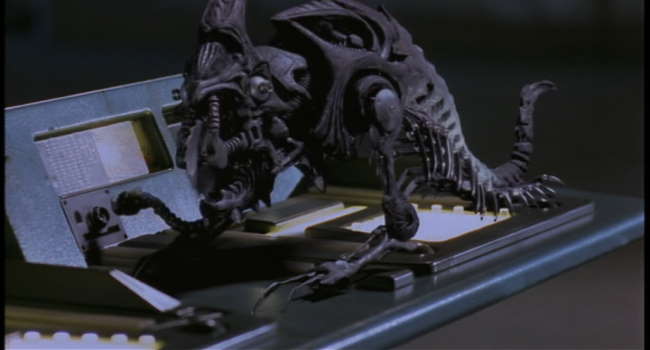
The Bottom Line: I’m really torn in deciding whether to give Screamers a 5 or a 6 star rating. This is not a great movie, but there’s just enough here to make watching it worthwhile. If you’re in to dystopic futures, especially ones involving outer space, you’ll probably want to see this. If you’re in to developing AI type movies, this also should hold interest for you. In terms of “cyberpunkness,” the same thing applies – there’s just enough here to include it as watchable cyberpunk, although you’d be find just calling this a space-sci-fi movie.
~See movies similar to this one~
Tags: cyberpunk movie review Screamers
Year: 2004
Directed by: Jeff Renfroe & Marteinn Thorsson
Written by: Jeff Renfroe & Marteinn Thorsson
IMDB Reference
Degree of Cyberpunk Visuals: Medium
Correlation to Cyberpunk Themes: Very High
Key Cast Members:
Simon J.: Jeremy Sisto
Derrick: Udo Kier
Howard: Lance Henriksen
Trish: Deborah Kara Unger
The Neighbour: Bruce Payne
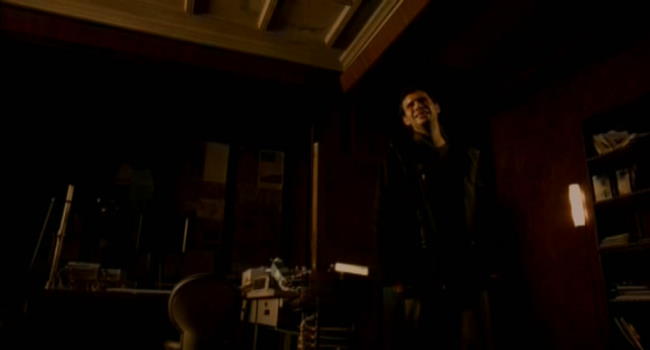
There are good people and there are bad people and they’re on their way,
and they want you, Simon…
The bad people can save you, but they won’t…
The good people want to save you but they can’t…
Overview: Every now and then I run across an absolutely extraordinary cyberpunk film, largely forgotten or ignored by the film going masses. More often than not, this film is foreign and never had a decent release in the US (where I’m from). One Point O (called Paranoia 1.0 in the US) is European a film that meets these criteria. Truly, you’ll be hard pressed to come close to finding an immersive film as One Point O. When you consider this was reportedly shot and produced on a budget of 1.7 Million, you begin to understand the enormity of what was accomplished here. No, you don’t get cool explosions or guns, or fancy CG effects, but you do get an absolutely awesome near-future dystopic story with a biting commentary on advertising and software development, all wrapped up in an extremely immersive, slow paced film. Everything is subordinated to the mood here, which is emphasized by the color choices and simple score. Unfortunately, I will need to be pretty vague in this review, as the ending definitely has a Sixth Sense type feel to it.
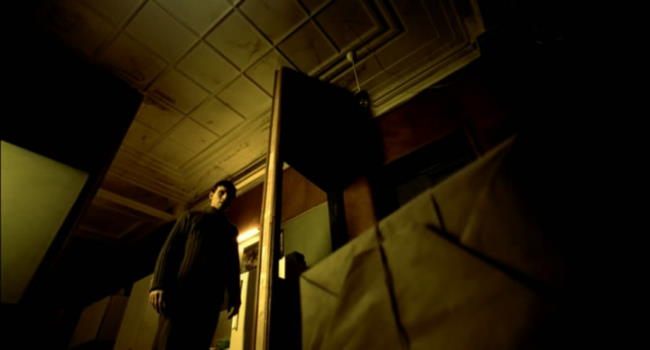
One Point O is about a computer programmer named Simon who works at home in a truly dingy, run down apartment building in a very shabby part of the city. He comes home to find a package waiting inside his apartment, and gets worried as nobody should be able to get inside. He opens the package, only to find that it was an empty box. This happens again and again, each time making Simon more and more paranoid. One top of this, he is late in delivering his the code he’s been working on to his customer. It appears as if his code has become infected with a virus, and worse, he really has a craving for milk!
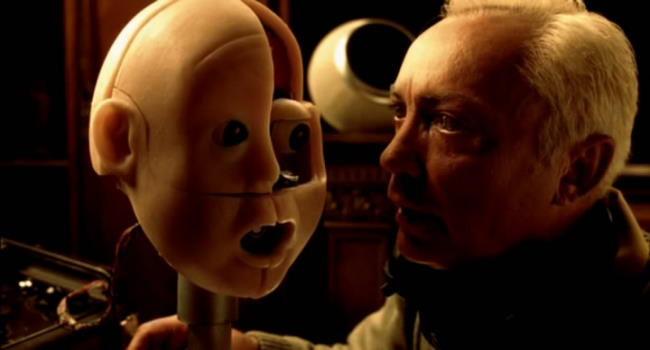
Every character in One Point O is quirky and memorable. Udo Kier (Ralfi from Johnny Mnemonic), one of my favorite role actors, plays an eccentric robotics hobbyist who has a nanotechnology-enabled couch that changes colors and cleans itself at the click of a button, and creates a sentient talking head in his spare time (this talking head named Alex has a penchant for making very prescient phone calls). Bruce Payne (Passenger 57, Hellborn) plays a neighbor VR game maker who creates S&M VR porn experiences by acting out the scenes with various partners. Deborah Kara Unger (Fear X) plays a cancer nurse in search of fleeting humanity wherever she can find it. Lance Henriksen (Bishop in Aliens) plays a strange, zen-like repairman who always seems to know what’s going on. Finally, Emil Hostina places a voyeuristic landlord who loves to eat meat. But its Jeremy Sisto who steals the camera - he’s simply terrific playing a normal guy overtaken by extremely weird events.
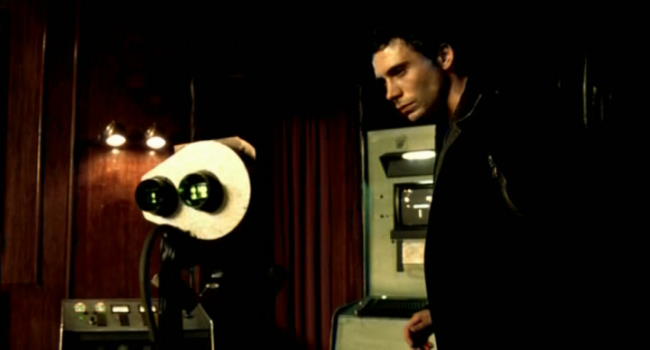
The Visuals: Like many cyberpunk movies, One Point O is dominated by a single color scheme - in this case we get a spectrum, from a yellow to pale orange to reddish-brown, with an occasional pale green as a highlight. Pretty much the whole movie (with the exception of the white convenience store which represents the corporation) takes place in those colors. Further accenting the dystopic quality is the continually run-down feel of the place. The apartment building is continually falling apart, as is virtually everything else except for the local drug store. While its clear that advanced technologies are the norm in this world, the people in One Point O have clearly been marginalized. They play with patchwork toys and out of date technology.
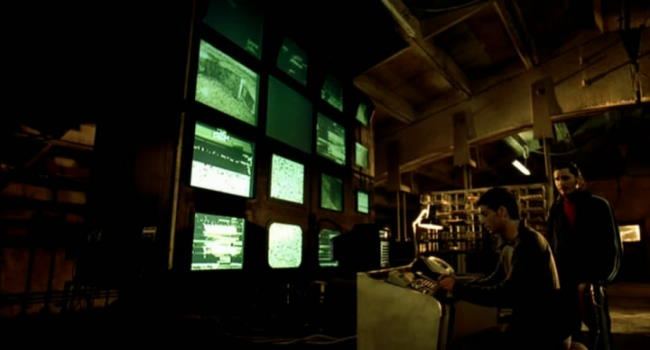
The cinematography is consistently interesting in One Point O, with many using floor shots with expansive backgrounds. However, in some cases, they probably go a bit over-board on the camera angles, such as the use of the close-up phone shot of old, which actually took attention away from the story telling. But again, this is a minor gripe, especially when we include the editing, which for the most part, is also outstanding. But in watching the deleted scenes, I do agree with the director’s commentary that a few shots probably should have been included, most notably the throw-up scene.

The Message: While I can’t go into the actual plot for fear of ruining the experience, I will say that One Point O has perhaps the most biting commentary on advertising and software development you will find anywhere. There is no question who is evil in this movie, even if they are rarely seen. Renfroe and Thorsson take to extremes and then crystallize problems they see in today’s world that form the basis for the story in One Point O. But they don’t state it in an in-your-face way - far to the contrary in fact. The story itself hammers home the message in the starkest manner possible.
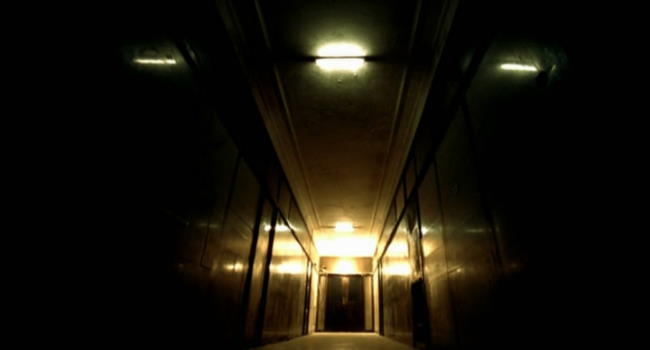
The Bottom Line: As long as you’re not looking for action or sleak visuals, but instead are looking for original cyberpunk themes done wonderfully well on a shoestring budget, One Point O is for you. One Point O is definitely a movie I would LOVE to talk about in detail but I cannot for fear of spoiling the terrific ending (maybe creating a spoiler thread in the meatspace would be the way to discuss it). The pacing has a slightly repetitive feel to it, but only because the movie progresses in a spiral pattern - the same basic pattern of events happen each pass, but events spin further and further out of control each time around. But again - go buy this movie (you’ll want to watch it more than once) - you won’t be disappointed.
~See movies similar to this one~
Tags: cyberpunk movie review paranoia
Year: 1993
Directed by: Albert Pyun
Written by: Rebecca Charles
IMDB Reference
Degree of Cyberpunk Visuals: Medium
Correlation to Cyberpunk Themes: Medium
Key Cast Members:
- Alex: Olivier Gruner
- Farnsworth: Tim Thomerson
- Angie-Liv: Cary-Hiroyuki Tagawa

~86.5% is still human~
Overview: Surprise surprise - another movie with Gruner playing a cyborg - this time by Martial Arts cyborg master, Albert Pyun. Like Gruner’s performance in Automatic (1994), Nemesis is also a decent “B” cyberpunk flick. In Nemesis, Gruner does his Robocop impersonation while trying to fight bad guys in the year 2027. In a well done style over substance movie, we get a nice underground war between cyborgs and humans. Throw in a good bit of Escape from New York and Blade Runner knock-off visuals and you have yourself an evening of trashy fun! Again, nothing new here, but the action is actually done well enough that you might want to give it a watch if you’re hankerin for mindless but fun Robocop knockoffs.
|






















































